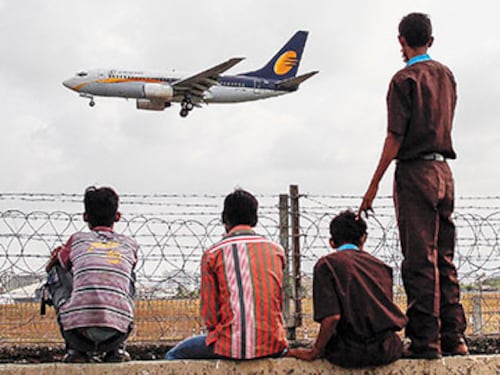Civil aviation policy aims to make flying affordable for the masses
The government's draft civil aviation policy plans to provide concessions to airlines to fuel growth, and make flying affordable for the masses


The Tata SIA Airlines Ltd’s research report on the contribution of aviation to the Indian economy makes lofty projections about the sector: It believes civil aviation in India has the potential to create an economic value of $250 billion and contribute to around 5 percent of the country’s GDP over the next 10 years. The report also foresees a three-fold rise in domestic air traffic by 2025.
There is a yawning gap between the projections and the ground realities (the sector is valued at $16 billion as of FY2015), but if the latest National Civil Aviation Policy (NCAP) draft is anything to go by, the government seems to be pulling its socks up to bridge it.
The draft policy, which was recently placed in the public domain to invite feedback from the stakeholders, lays emphasis on 16 critical areas of the civil aviation industry ranging from safety to regional connectivity, bilateral traffic rights, maintenance, repair and overhaul operations, fiscal support and air navigation services, among others.
Says Jitender Bhargava, former executive director of state-run Air India, “It is the best draft policy in the last 20 years. It is streets ahead of others [six other civil aviation policies drafted by past governments], touching all aspects of aviation.”
Phee Teik Yeoh, CEO, Vistara—Tata SIA Airlines Limited, agrees: “It is a fairly comprehensive approach that will help unleash the potential of the aviation sector in India.”
For the first time, the policy talks of concessions for airlines to fuel growth. Some of the fiscal concessions include service tax and customs duty exemptions for various sub-sectors of the aviation industry, and exemption from paying various airport-related charges.
There is also talk of providing free land for the development of airports. In fact, the government is looking at building “no-frill” or low-cost airports, which could give a fillip to air travel in smaller towns. (Currently around 75 out of 476 airstrips/airports in India have scheduled operations.) “This industry has been known to be like a cash cow for the government, so it’s good to see concessions being talked about,” adds Bhargava.
The draft also has the government clearly spelling out its objective: To make flying affordable for the masses. “For example, if every Indian in the middle-class income bracket takes just one flight per annum, it would result in a sale of 300 million tickets, a big jump from the 70 million domestic tickets sold in 2014-15. This will be possible if the airfare, especially on regional routes, is brought down. The reduction in costs will require concessions by the stakeholders, primarily the central and state governments and airports,” reads the draft NCAP 2015.
The first vision statement in the draft NCAP 2015 speaks of creating an ecosystem that will enable 30 crore domestic tickets to be sold by 2022 and 50 crore by 2027, from the current seven crore.
One of the ideas floated by the government is to cap fares at Rs 2,500 (all-inclusive) per passenger for a one-hour flight on select regional routes. While this is a huge leg-up for passengers in Tier-II and Tier-III towns, regional airlines aren’t quite excited. “We believe it isn’t viable,” says Shyson Thomas, managing director of Air Pegasus, which operates a fleet of turboprop aircraft in south India. “When you operate at costly airports such as the Kempegowda International Airport, Bengaluru, out of that Rs 2,500 we may have to spend Rs 1,800 on paying various fees to the airport operator.”
That apart, Thomas is upbeat about certain other provisions of the draft policy. “The policy has recommended that airlines can carry out their own ground handling operations and need not be dependent on third-party operators. This will benefit airlines as we will save a lot of money,” he says.
Greenfield airports don’t allow airlines to undertake their own ground handling operations, but insist that they avail the services of third-party operators who are concessionaires at the airport. “Over and above our ground handling charges, we stand to lose 14 percent as service tax and another 13 percent as royalty payable to the airport operator,” adds Thomas, whose ground handling services company Decor Aviation operates across 13 airports in south India.
Another sore point with newer airlines is the ambiguity over the 5/20 rule, which allows Indian carriers to fly abroad only after completing five years of domestic operations and having a fleet of 20 aircraft. The draft NCPA 2015 has proposed three options: Abolish the rule continue with it or introduce the concept of Domestic Flying Credits based on which Indian careers will be allowed to fly overseas.
“It was surprising to see the lack of clarity or progress on the 5/20 rule. This is one significant, archaic and regressive policy that would have unbridled the entire sector and shown optimism not only to current incumbents but also to potential future investors in the sector,” says Mittu Chandilya, CEO & MD, AirAsia India.
The Tata-SIA research report notes that there are no “global parallels to this rule” and goes on to term the regulation as being “discriminatory” to Indian airlines. It highlights that while foreign carriers are allowed to operate in Indian skies, Indian airlines cannot enjoy reciprocal rights.
“The 5/20 rule should be abolished unconditionally and immediately to benefit India as its removal will spur investment, tourism and employment. It will signal a liberal market friendly regime to Indian and global investors,” says Yeoh of Vistara. “It is time that the Indian aviation sector is allowed to reach its full potential by getting freedom from restrictive rules.”
First Published: Dec 08, 2015, 06:36
Subscribe Now